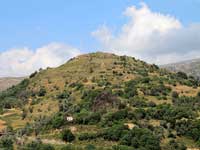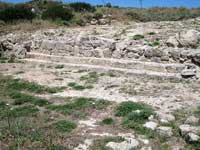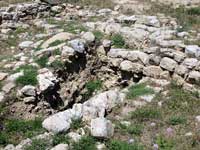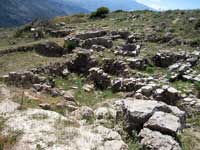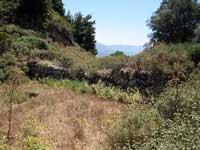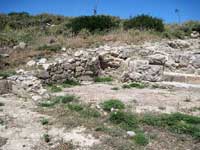.
Sybrita (minoisch SU-KI-RI-TA [1], ancient Greek Σύβριτα Syvritos, was an ancient city In the Amari Basin on the Greek Mediterranean island of Crete. It consisted of about 1400 BC. Chr. Until its destruction during the Arab conquest of the island in the year 824 n. Chr. Remains of the plant were on the 618-meter high Kefala (Κεφάλα) west at Thronos (Θρόνος), a village 19 km east of Rethymno, excavated.
location
The greatest extent reached the ancient Sybrita in the Hellenistic period. At that time the city from today Klisidi (Κλησίδι) in the Northeast reached as far as Agia Fotini (Αγία Φωτεινή) in the southwest and Genna (Γέννα) in the south. [7] Klisidi and Agia Fotini are located about one kilometer from the former acropolis of the city on the hill Kefala ("big head") at Thronos, not a single kilometer away.
The sphere of influence of the city extended over the entire Amari Basin, one of the small river Platy (Πλατύ) irrigated fertile valley between Rethymno on the north coast of Crete and Agia Galini (Αγία Γαλήνη) at the south coast or Tymbaki (Τυμπάκι) on the western edge of the Messara -Level. Agia Galini was home to the port of Sybrita, the ancient Soulia (Σουλία) or Soulena (Σουλήνα). [8] About 5.5 kilometers southwest of the Acropolis, in a cave near Patsos (Πατσός), a sanctuary of Hermes Kranaios is evidence that existed since the late Minoan period I (LM I) intermittently until the Roman period. [7]
The Sybrita of antiquity is the name given to today's municipality of Syvritos with the main town Agia Fotini within the municipality (Dimos) Amari in the regional district Rethymno. By 2010, Syvritos was an independent municipality, encompassing the western part of the Amari Basin, before being merged with the east-bordering former municipality of Kourites to the large community of Amari.
story
The Sybritas were founded in the late Minoan period, the so-called Third or Post-Palaeolithic period. During this period the Mycenaeans ruled over Crete. [9] In the palace found at Knossos writing tablets in Linear B, the name of the city with sufficient probability as Su-ki-ri-ta (Sugrita) is mentioned, [10] which means "city of wilden Ebers / Boar". [7 ] In excavations on 2400 m2 of the Acropolis occupying an area of 110 × 80 meters [11] on the Kefala, the foundation walls of three buildings from the 12th century BC were found in the north-west of the summit. Chr. Was discovered. They are still the oldest archaeological evidence for the settlement of the urban area.
In the following period (1200 to about 650 BC) Sybrita was inhabited throughout. From the "Dark Centuries", building blocks on the Kefala have been preserved, which are assigned to the Geometrical Period (about 900 to 700 BC). They are located in the north-east and south of the summit. According to the findings of the excavation, a public building built there was built until the early seventh century BC, Chr. Rich surface finds on the southern slopes of the Kefala point out that in the following Archaic period (about 700 to 500 BC) to the classical period (about 500 to 336 BC) the city was located ,
Fence wall at the foot of Kefala
The Hellenistic era (336 to 30 BC) meant a period of growth and prosperity for Sybrita. The settlement area stretched to the southwest to today's Agia Fotini, which resulted in emergency excavations. The construction of the isodomic fortification wall, consisting of hewn square blocks of uniform size, from which a narrow part between the hills Kefala and Keratidi is preserved, is dated to this period.
As early as the fourth century BC, Coins of the city, statues, were minted. Sybrita was thus one of the first Cretan cities with its own coins. [12] Of these, about 15 are known today. They depict the gods Dionysus, Hermes and Zeus. The town of Gortyn (Γορτύν), which was allied with Sybrita, was divided between 360 and 330 BC, The mint motif of Europe on a plane tree, and of Zeus in the shape of a bull. [13] Some of the coins contain the word ΣΙΒΡΙΤΙΩΝ (SIBRITION) as an inscription. In foreign policy, alliances with the Ionian city of Teos (201 BC) and the Cretan cities with Eumenes II of Pergamum (182 BC) are handed down in inscriptions.
After the occupation of Crete by Quintus Caecilius Metellus 69 BC, Chr. [14] and the inclusion of the island in the Roman Empire flourished Sybrita by its location between the Roman island capital Gortyn and Eleutherna (Ἐλευθέρνα) and the north coast at Rhithymna (Ῥίθυμνα). The prominent position of the city is documented by an entry in the Tabula Peutingeriana, a Roman road map from the second half of the 4th century AD. [15] The distance to Eleutherna is indicated there with 8 miles (VIII milia passuum), about 12 kilometers. On the southern plateau of the Kefala, the center Sybritas, the remains of a large public building are preserved. The building dates from the 1st to the 3rd century AD and has a paved ramp from the south.
Marienkirche (Ναός Παναγίας) in Thronos
Other architectural remains from Roman times were discovered during the emergency excavations in Thronos and Agia Fotini. On the northern slope of the Kefala, a Roman burial chamber was found, which together with Grabinschriften from the southern Genna point to the borders of the city area with the cemeteries there. In Thronos the foundation walls and parts of the floor mosaic of an early Christian basilica from the 5th or 6th century have been preserved. [16] Sybrita was in the Byzantine era until the destruction of the city by the Arabs in 824 Bischofsitz. On the ruins of the basilica was built in the 14th century the much smaller, still preserved church of the Virgin Mary (Ναός Παναγίας) of Thronos.
The position of Sybrita south-west of the Psiloritis massif at the Kefala near Thronos was identified by Thomas Abel Brimage Spratt in 1865. [18] Inscriptions, many of which were discovered by Federico Halbherr in 1894, gave evidence of the ancient city. During the occupation of Crete in the Second World War, 1942, Ernst Kirsten, the German historian, led to the first small excavations at selected places. The British archaeologists Sinclair Hood, Peter Warren, and Gerald Cadogan of the British School at Athens released the remains of a settlement from the post-palatial and geometrical periods on the Kefala in 1962. [17]
Since 1986, regular archaeological excavations took place on the summit of the hill under the direction of Luigi Rocchetti and Niki Metaxa Prokopiou, starting from 1999 under the guidance of Anna Lucia D'Agata. [17] Many of the finds, including vases, figures, metal objects and some coins, are now in the Archaeological Museum of Rethymno. [19]
Buildings of the ancient Sybrita on the Kefala hill
Remains of late Minoan buildings (SM III C)
Minoan Building 2 (north side of the summit)
Remains of Roman buildings on the Kefala
Roman building A2 (south side of the summit)'
Literature
Thomas Abel Brimage Spratt: Travels and Researches in Crete. John van Voorst, Paternoster Row., London 1865.
John Devitt Stringfellow Pendlebury: The Archaeology of Crete. An Introduction. Taylor & Francis, London 1939, ISBN 0-416-72590-2.
Sinclair Hood, Peter Warren, Gerald Cadogan: Travels in Crete. 1964.
Niki Metaxa Prokopiou: Sybrita Amariou: First Indications for a New LM III C Site. In: La transizione dal Miceneo all’Alto Arcaismo, dal palazzo alla città. Atti del convegno internazionale, Roma 14-19 marzo 1988. Rom 1991, S. 373–401.
Luigi Rocchetti (Hrsg.): Sybrita. La valle di Amari fra bronzo e ferro. 1, Gruppo editoriale internazionale, Rom 1994.
Anna Lucia D’Agata: Ritual and rubbish in Dark Age Crete. The settlement of Thronos-Kephala (ancient Sybrita) and the pre-classical roots of a Greek city. In: Aegean archaeology. 4, 1997–2000, S. 45–59.
Anna Lucia D’Agata: Defining a Pattern of Continuity During the Dark Age in Central-Western Crete: Ceramic Evidence from the Settlement of Thronos/Kephala (Ancient Sybrita). In: Studi micenei ed egeo-anatolici 41/2. 1999, S. 181–218 (englisch, Digitalisat [PDF; 3,0 MB; abgerufen am 26. Dezember 2016]).
Elisabeth Mlinar: Befestigte Städte, Siedlungen und andere fortifikatorische Anlagen auf Kreta von der archaischen bis zum Ende der hellenistischen Zeit. Dissertation. Band 1. Universität Wien, Wien 2014, Thronos, Kephala/Sybrita, S. 64–66 (Digitalisat [PDF; abgerufen am 26. Februar 2017]).
Einzelnachweise
John Younger: Linear A Texts in phonetic transcription & Commentary. 10c. Place Names. people.ku.edu, 10. Februar 2012, abgerufen am 21. Februar 2012 (englisch).
Pseudo-Skylax p. 18. Belegstellen für die Namensformen angegeben nach William Smith (Hrsg.): Dictionary of Greek and Roman Geography. 1854 (online [abgerufen am 9. Juni 2010]).
Claudius Ptolemäus 3, 17, 10.
Hierokles.
Polybios bei Stephanos von Byzanz sub voce.
Corpus Inscriptionum Graecarum 2, S. 637.
Mogens Herman Hansen, Thomas Heine Nielsen: An inventory of archaic and classical poleis. Oxford University Press, Oxford/New York 2004, ISBN 0-19-814099-1, S. 1187.
David J. Blackman: Soulia or Soulena (Agia Galini), Crete. In: Richard Stillwell u. a. (Hrsg.): The Princeton Encyclopedia of Classical Sites. Princeton University Press, Princeton NJ 1976, ISBN 0-691-03542-3.
ΟΙ ΑΡΧΑΙΕΣ ΠΟΛΕΙΣ ΤΗΣ ΚΡΗΤΗΣ (Με αλφαβητική σειρά). www.kairatos.com.gr, abgerufen am 10. Juni 2010.
John Chadwick: The Mycenaean world. Cambridge University Press, Cambridge 1976, ISBN 0-521-21077-1, S. 54.
Sebastian Zöller: Die Gesellschaft der frühen „Dunklen Jahrhunderte“ auf Kreta. (PDF; 1,4 MB). Heidelberg 2005, S. 103.
Sybrita or Sybritos (Thronos) Amari district, Crete. www.perseus.tufts.edu, abgerufen am 28. Juni 2010.
Münzen aus Sybrita, S. 19 (67). www.kuenker-muenzen.de, abgerufen am 23. Juni 2010 (PDF).
Klaus Hylla: Die römischen Provinzen – Gallia Narbonensis, Cilicia, Creta et Cyrena. (Memento vom 17. Juli 2012 im Internet Archive) auf: meinebibliothek.de
Tabula Peutingeriana. www.euratlas.net, abgerufen am 23. Juni 2010.
Johan de Bakker: Across Crete: From Khania to Herakleion. Logos Tekstproducties, Amsterdam 2001, ISBN 90-806150-1-3, S. 109.
Sybrita Archaeological Project – Thronos Kephala (Storia della ricerca). www.sybrita.org, abgerufen am 16. Juni 2010.
Johan de Bakker: Across Crete: From Khania to Herakleion. Logos Tekstproducties, Amsterdam 2001, ISBN 90-806150-1-3, S. 125.
Stella Kalogeraki: Rethymnon – Die Seele Kretas. Mediterraneo Editions, ISBN 960-8227-15-1, S. 56.
| Ancient Greece
Science, Technology , Medicine , Warfare, , Biographies , Life , Cities/Places/Maps , Arts , Literature , Philosophy ,Olympics, Mythology , History , Images Medieval Greece / Byzantine Empire Science, Technology, Arts, , Warfare , Literature, Biographies, Icons, History Modern Greece Cities, Islands, Regions, Fauna/Flora ,Biographies , History , Warfare, Science/Technology, Literature, Music , Arts , Film/Actors , Sport , Fashion --- |
Retrieved from "http://en.wikipedia.org/"
All text is available under the terms of the GNU Free Documentation License


